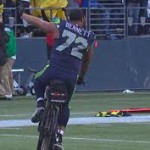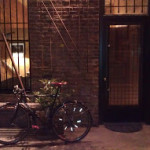Working on the annual Bike to Work Week campaign to encourage more bicycling in Spokane was incredibly rewarding. In a continuation of lessons learned from putting on a commute challenge, here are a few more takeaways.
In Part 1:
- How do you get started?
- What miles count?
- What motivates people?
- What’s wrong with May?
- Does it work?
What Can You Do with the Data?
Bike advocacy gold, baby! We took our miles traveled by bike and calculated every possible benefit: Money saved at the gas pump at current prices and average mileage, calories burned, CO2 emissions avoided.
We put all that data into press releases, speeches, and follow-up presentations to City Council (captured on cable and replayed many times). This really showcased both the number of people riding (far higher than I think people had assumed) and the benefits of our transportation choice and we got great media coverage as a result.
Phase 2: Use all that contact information to keep those people in the loop on bike issues as they unfold in your community. I didn’t stop emailing after the reminders about the pancakes, the mid-week energizer stations, and all the rest wound down.
Every so often I’d send out a round-up of local bike news–things like upcoming hearings on a bike master plan update, local bike events, people announcing as candidates for public office who made it clear they intended to support investments in a transportation system that works for every way of getting around. We kept together as a community of people interested in better policy for better bicycling.
This ongoing communication also let me keep scrubbing the email list as I got bouncebacks or heard back from someone that he/she had moved away and wouldn’t be around to ride with us any more, so I started off the next year with a nice clean data set. You went to all this effort to get these people to self-identify as bicyclists–don’t just drop them until next year!
Outcome? The first year it took us five weeks to get from zero to 300 people registered. In year 2 we got there in two weeks. We were over the previous year’s registration by May 5 and reached 1,472 by the events week–over a 57% increase. The next year we registered over 2,200 people.
What Does It Take to Pull This Off?
- A dedicated band of volunteers who will do what they say and stick to a timeline.
- The discipline to recognize that the easy, fun thing everyone will jump onto is generating lots of awesome ideas–the tough part is winnowing that long list down to those ideas that someone will actually execute so you only bite off what you can chew. Our rule: If someone wants to see something happen, that person has to head up that effort or someone else has to agree to take it on. If no one will, it isn’t important enough to the group as a whole to add to the to-do list.
- Local business sponsors to help come up with some prizes and support for the promotional and event costs you’ll incur (posters, banners in your downtown if you can, maybe some donated print advertising from the local paper, sources of things like pancakes and coffee at a kickoff or a Friday-night wrap-up party for Bike to Work Day).
- A registration system: See below for what Tri-Cities is doing in conjunction with the National Bike Challenge.
- A promotional plan so have someone on the committee who can write press releases/blog posts, set up your Facebook page, etc. and who will keep up that effort throughout the registration drive. This is not a “set it and forget it” event, especially when it’s new.
- A succession plan: What happens when your founders move on to other things? Key volunteers who get everything rolling often carry a lot of lessons learned in their heads. Get them to write down the checklist and timeline for their set of responsibilities and put all that someplace central where more than one person has the log-in and password. Recruit and train assistant leaders for every subcommittee.
How Do You Help the Beginners?
As a warm-up I think it’s easier for people to try riding for an errand or a social engagement on a weekend than to have the time pressure of needing to be at a particular place by a particular time with a particular type of clothing. I usually advise people to try their work commute first on a Saturday or Sunday if they’re really new so they can see how long it takes, get used to some of the decision points that feel different on a bike, and so forth.
For those putting on a local challenge you might have some pre-rides on a weekend. Meet at a local bike shop–the owner will probably be happy to work with you on some kind of bike check-up special deal to get more customers in the shop. Go over the rules of the road (and get in touch with us if you want a batch of our pocket-sized guide to Washington bike laws to hand out).
We also worked with our local League-Certified Instructors (LCIs) to put on Traffic Safety 101 skills courses during mid to late April to help prepare people.
Local to National–Think Big!
To address this pesky weather thing (see “What’s Wrong with May?” in Part 1) you can also incorporate the National Bike Challenge. It runs through September and counts ALL kinds of riding, whether it’s mountain biking, commuting, tooling around, going on a bike tour vacation, or sprinting toward the finish line.
In addition to counting all types of riding it runs longer so people who have travel conflicts or bad weather during May still have the chance to get in some miles that count, and it makes a national statement.
You can sign up for both your local commute challenge and the national one and have the chance to win prizes, including prizes at the state level that we’re donating from the Bicycle Alliance as the statewide host.
At the Bicycle Alliance we’ve worked with the League of American Bicyclists, who organize the National Bike Challenge, on behalf of 3 Rivers Bicycle Coalition so they can use the national system to run their local challenge, and they’re rocking the registration–they’re the top community in the state for the national challenge so far!
If you want to start a community challenge without having to set up all the separate registration and what-not, let us know and we’ll work with you for next year to give the Tri-Cities a run for their money.
Bottom Line: Just Do It!
Your community will be a better place for bicycling if you step up and help make it more visible. If your town or county isn’t on our statewide list of commute challenges this year, take this as your own challenge to get started planning for next year!
Let us know you’re working on it and we’ll help you connect with other bicycle advocates in your area. You’ll have a head start on that list of people you send emails to for the first planning meeting.




One Comment
While it was great to be able to separate Benton and Franklin Counties for the purposes of our own local challenge, it messed up the statewide challenge by effectively removing those two counties. We hope that BAW and others, working with LAB, can get Endomondo to recognize three levels: national, state, and local.
One Trackback
[…] Commute Challenge Lessons Learned: Part 2 […]